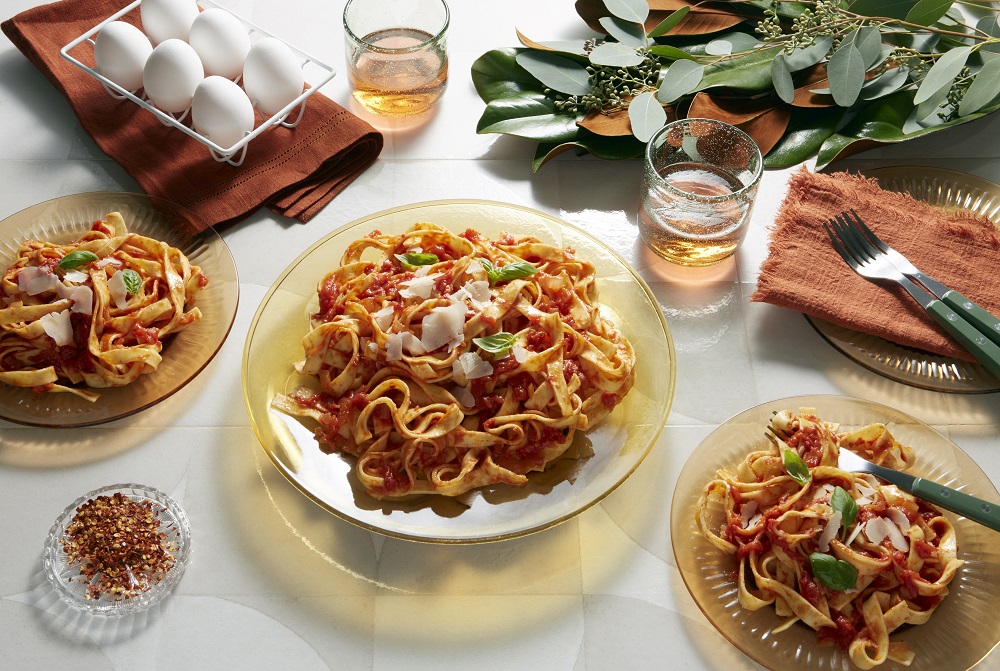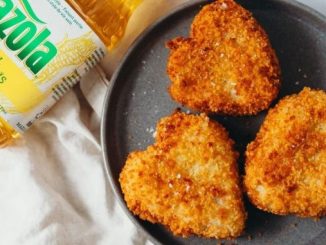Nothing conjures up warm, nostalgic memories quite like classic, retro holiday dishes. To embrace the magic of the season, Egg Farmers of Canada is partnering with renowned Canadian chefs to put a fresh spin on timeless recipes inspired by their own celebrations.
Chef Matt Basile’s Fettuccine Pomodoro brings classic Italian flavours to your table with homemade fettuccine. Made with Canadian eggs, of course, this silky pasta pairs perfectly with Chef Matt’s slow-simmered tomato sauce or the sauce of your choosing – perfect for festive occasions and beyond.

Fettuccine Pomodoro
Serves: 4
Prep Time: 120 min
Cook Time: 240 min
Ingredients:
For Sauce
- 3 tbsp (45 mL) olive oil
- ⅓ cup (75 mL) finely chopped Spanish onion
- 2 cloves garlic, finely chopped
- ½ tsp (2.5 mL) chili flakes (optional)
- 2 28 oz canned tomatoes, crushed by hand
- 1 large carrot, peeled
- 2 tbsp (30 mL) butter
- Salt to taste
For Pasta
- 2 cups (500 mL) pizza flour, semolina flour or all-purpose flour
- 3 large eggs
- ½ tbsp (7.5 mL) olive oil
- Salt to taste
For Pasta Garnish
- Freshly grated parmesan cheese to taste
- Cracked pepper to taste
- Salt to taste
- Fresh basil
Tools
Pasta machine or rolling pin and knife
Directions:
For Sauce
- Heat the oil on medium-high heat in a medium to large-sized saucepan. Add the chopped onion, garlic and chili flakes (if using). Stir constantly for 2-3 minutes.
- Add a small scoop of the tomato water from the canned tomatoes to softened onions and garlic*. Stir until absorbed. Once the onions and garlic have fully absorbed the liquid, repeat 2-3 times. Tip: *Wait until the onions are soft before adding the tomato water. This step ensures proper absorption and a balanced flavour.
- Add the crushed tomatoes to the saucepan along with one can’s worth of water. Reduce the heat to a low, add the carrot and simmer uncovered for 2 hours.
- After 2 hours, remove the carrot and stir in the butter and salt. Taste the sauce to check the balance between sweetness and acidity. If the sauce is too acidic, add another can’s worth of water.
- Continue cooking the sauce on a low simmer for an additional 1 to 2 hours.
For Pasta
- On a clean surface, form a nest with the flour. In the centre, add eggs, olive oil and a pinch of salt.
- Using a fork, gently break up the eggs while maintaining the flour walls as best as you can. Once about 80% of the eggs are mixed in, use your hands to fully combine the ingredients into a dough ball.
- Knead for 8-10 minutes until the dough is moist, smooth and tight. If the dough feels dry, add a small amount of water and continue to work. If the dough is too sticky, sprinkle it with flour. Place the dough ball in a glass bowl, cover tightly with plastic wrap and let rest at room temperature for at least 30 minutes.
- Cut dough into 4 pieces using a dough cutter or large sharp knife (if using a knife, don’t saw the dough, cut by pressing down with the knife in one motion). Flatten each piece into an oval shape. Feed the dough through a pasta maker on the widest setting 3 times or roll it out using a rolling pin. Fold the short edges inwards (like a tri-fold folder), then fold them in half again. Continue to run the dough through the pasta maker on increasingly thinner settings or roll out with a pin until the desired thickness is achieved. If you’re using a rolling pin, roll out the dough until the dough is as thin as you can.
- Lightly flour a baking sheet. Place the pressed dough into the flour and then sprinkle more flour on top. Run the dough strips through the fettuccine setting on the pasta maker or cut into strips 6 to 9 mm wide. Spin the pasta into mini nests and let air dry for 30 minutes before cooking. If you don’t own a pasta maker, lightly flour the top of the dough and roll it up loosely before slicing it into ½ cm thick strips.
- Bring a large pot of salted water to a boil. Cook the pasta for 30-45 seconds, then transfer it to a saucepan and cook over low heat with a small knob of butter and a spoonful of sauce until the sauce is absorbed by the pasta.
- Gradually add more sauce, stirring until the pasta is thoroughly coated and reaches your preferred doneness (about 1-2 minutes for al dente or an extra 1-2 minutes for a softer texture). Serve with freshly grated parmesan cheese, cracked pepper, salt and fresh basil leaves for garnish.




